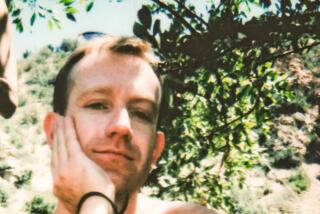THE NEW LIFE.<i> By Orhan Pamuk</i> .<i> Farrar, Straus & Giroux: 296 pp., $24</i>
- Share via
Under the sway of romances and tales of chivalry, Don Quixote took up lance and shield and wandered about to battle injustice and the general wrong. Her head filled with sappy love novels, Madame Bovary took to adultery and the romantic swoon. Young Dorian Gray was given the book of all mind-altering books, “a poisonous book,” he came to call it, and, after reading it, he abandoned his fiancee, his closest friend and a life of Victorian rectitude to emerge as a suave decadent and prophet of a new hedonism.
Books and their influence--if any--have been the concern of many, especially today when the allure and power of serious fiction seem challenged by the values of marketplace. Can we, bombarded by the sensations of daily life, still read with the oneness and innocence of our childhood and youth, with the fresh wonder of that time, when books spoke to us from the deepest sphere of imagination?
In Orhan Pamuk’s “The New Life,” the power of art’s magic still reigns over the imagination of the main character, as revealed in the novel’s opening sentence: “I read a book one day and my whole life changed.” The change is dramatic and takes the narrator, Osman, a 22-year-old Turkish student, away from his studies and his widowed mother into a new, adventure-filled life. The book, whose subject we never learn, infuses him with light, possesses his thoughts, occupies his every moment and propels him, finally, on a search for the book’s meaning for him and for the new life that it has promised.
His new life begins quickly when, soon after reading the book, he falls in love with a young architectural student, Janan who, along with her lover, Mehmet, has also fallen under the book’s spell. The readers of the book are in some danger, Mehmet warns the narrator, because mysterious persons are hunting them down and killing them. This danger proves to be real when Osman sees Mehmet shot and wounded in the street and when he later finds no trace of him or of his beloved Janan. Both have disappeared.
Now Osman pulls up stakes to pursue the dream of a new life along with the hope of being visited by an angel also promised by the mysterious book. He also journeys forth to search for Janan who is out there, somewhere, in the vast Turkish interior. This double quest takes Osman on the road, burning like some wild Kerouac character for whom the road is life. But this is a voyage of bus, not car, rides. Osman buses across Turkey, stopping only long enough to take another bus in no direction in particular, hoping that the change of buses will lead him to the book’s ultimate revelation.
This is the most compelling section of the novel--the writing drives and flows with a pitch as intense as the narrator and his quest. The hour is always emotional dusk and the tone is lyrical: “Night: A long, very long and windy night. Dark villages and even darker sheepfolds, immortal trees, sorry service stations, empty restaurants, silent mountains and anxious rabbits went past the dark mirror of my window.”
One night his bus crashes, but he emerges from the bloody wreck alive and wanting now to find the sites and wrecks of other bus collisions. At one such accident site, he finds Janan, and the two begin riding buses together: He in love and she tender but removed. Months pass in these travels to nowhere until their bus crashes. A young woman in her dying moments reveals herself as a reader of the book and asks Osman and Janan to impersonate her and her lover, who lies dead in the wreckage. They must go, she says, to a Dr. Fine, the man who is behind the violent attacks on readers of the book.
Armed with the identity papers of the two young dead lovers, they set off and find Fine, a rich landed man who reveals that he had a son who had turned against him after reading the book, a son whose life had gone to pieces and who Fine believed had been incinerated in a bus crash. In revenge for what the book had done to the young man and to all those who had come to grief after reading it, Fine organized a terror against all the book’s readers and against all printed books. The book was just one among many instruments of the great conspiracy--Coca-Cola and Marlboros being some of the others--that originated in the West and that were bent on destroying authentic Turkish culture.
It was one of Fine’s agents who shot Mehmet, not realizing that he was really Fine’s son and had assumed a new name after leaving his father’s estate. Another agent murders Uncle Rifki, the anonymous author of the book and a friend of the narrator’s family. Saying he will return in five days, Osman leaves an ill Janan behind and sets out to find Mehmet.
Of course, Osman does find Mehmet in a small village, where Mehmet has taken yet another name--the narrator’s--and where his new life is “ordered, disciplined and punctual.” He is a contented man. He spends his days copying by hand every line, word and punctuation of the book and lives off their sales. He loves Janan still but does not plan to see her or to do anything but live as he does in reclusive pleasure. It is this monkish Osman that Osman-the-narrator shoots and kills with a pistol given him by Fine.
Osman returns to learn that Janan has left the estate. All his attempts to find her fail. Having concluded all adventures and all hopes of the promised illumination, he returns to Istanbul and his mother. Janan, he learns years later, married and lives in Germany with a doctor who had read the book but whose life had not suffered from the experience. Now a man of 35, married and with a daughter, Osman lives a quietly pained life, a man who drinks and falls asleep in front of the TV.
The novel would have reached a natural conclusion had it ended here. A tale of the collapse of a young person’s illusions and hopes for a life more intense than most are born to live speaks to us all, young or not. But the novel goes on in yet another vein, adding yet more complications and convulsions to the story’s already overstretched coincidences, its belabored symbolism, allegory and plot.
The story continues in an unexpected literary vein, exploring the influences of Dante, Jules Verne and Rilke on the writing of the book whose title, we belatedly learn, is the same as the novel we are reading. We have suddenly left the novel’s deranged and passionate world and find ourselves in the classroom with our narrator turned literary explicator.
For all the blood spilled in the novel’s bus crashes, there is very little of it in the novel’s characters. Janan is just the figure of the unattainable Muse. Mehmet is just the narrator’s cut-out double. Finally, despite the novel’s rhetorical insistence on the lyrical mystery of life and the narrator’s quest, little felt mystery but much hocus-pocus remains.
More to Read
Sign up for our Book Club newsletter
Get the latest news, events and more from the Los Angeles Times Book Club, and help us get L.A. reading and talking.
You may occasionally receive promotional content from the Los Angeles Times.








